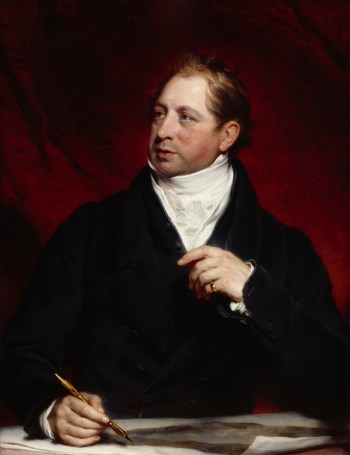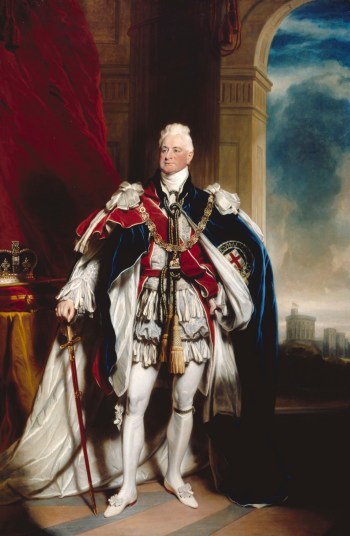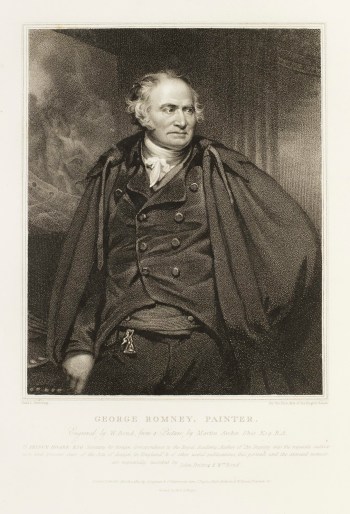Sir Martin Archer Shee PRA (1769 - 1850)
RA Collection: People and Organisations
Martin Archer Shee was born in Dublin to Martin Shee, a merchant, and his wife Mary Archer, who died in 1771, when Shee was still an infant. His father left Dublin with his two young sons and settled in Cookstown, County Wicklow, where Shee and his brother George were looked after by their mother’s widowed sister, Mrs McEvoy.
Shee’s father moved back to Dublin in 1781 where Shee was able to receive a classical education under the Dominicans. When his father died in 1783, Shee and his brother were effectively adopted by their aunt McEvoy and her new husband, a Mr Dillon. Around this time, Shee also began studying at the drawing academy of the Royal Dublin Society, where he won the majority of premiums awarded. His aptitude for drawing and unstable family position led Shee to leave home at the age of 15 and establish himself as a portrait painter in pastels. By 1786 he was receiving numerous commissions from elite society figures. Buoyed by his success in Dublin, Shee travelled to London in 1788 where he lodged in Covent Garden.
Although he had several contacts with established artists already in London, such as Sir Joshua Reynolds, Benjamin West and John Opie, Shee forged his own practice as a portraitist and exhibited his first two portraits at the Royal Academy Annual Exhibition in 1789, a year after he moved to London.
His career took a decisive step forward in 1790 when he got to know his cousin George Shee, a wealthy nabob (a term for individuals whose wealth derived from involvement with the East India Company). George Shee provided a link to the upper circles of London society, and notably showed some of his cousin’s works to distinguished guests at a dinner in February 1790. This resulted in Shee’s introduction to Edmund Burke and his close friend Reynolds, and Shee entered the Royal Academy Schools in November of that year.
From 1792 until 1845, Shee exhibited paintings annually at the Royal Academy, mostly portraits but also a few genre and ‘fancy’ pictures. His reputation grew on the strength of his portraiture, and he was elected an associate of the Royal Academy in 1798, becoming a full Member in 1800.
In 1796, Shee married Mary Power from Co. Cork, Ireland. The marriage was opposed on both sides due to lack of means, but the match was a happy one.
Following his election to the Royal Academy, Shee was commissioned by the Liverpool chamber of commerce to paint a portrait of the Duke of Clarence, later King William IV. This commission led to further aristocratic clients, establishing Shee as one of the foremost portraitists of the age. He painted portraits of William IV and Queen Adelaide in 1834 and of Queen Victoria in 1842.
Shee travelled to Paris in September 1802 with other artists to view the collections of artworks looted by Napoleonic armies and on display in the Louvre. He also had the opportunity to observe Napoleon at close hand, noting in his letters and journal his admiration for the French leader. However, over the next few years as the threat of an invasion of Britain by Napoleon increased, Shee revised his opinion and even sought (unsuccessfully) to raise a volunteer force from among the Royal Academicians to oppose Napoleon.
In the early 1800s, Shee also emerged as a writer and poet, publishing a poetic discourse on art in 1805 to great acclaim. Over the following decades, Shee published further literary works and novels, with varying levels of success.
Shee was also – and perhaps most notably – a key figure within the governance and administration of the Royal Academy. He first became involved in the politics of the institution in 1805, when he intervened on an issue relating to the Hanging Committee for that year’s exhibition. The case concerned one of John Hoppner’s paintings that was deemed to be unfairly rejected due to late submission (Hoppner had been too ill to make the original date) even though James Northcote’s painting – also submitted late – was accepted. Shee’s determination to ensure fairness earned significant and lasting respect from fellow Academicians.
In 1830 Shee was elected President of the Royal Academy, succeeding his friend Sir Thomas Lawrence. Shee steered the Academy through several difficult moments, including public criticism and a parliamentary enquiry into the principles of academies. He also oversaw the relocation of the Academy from Somerset House to the National Gallery.
Shee moved to Brighton in June 1845 for health reasons, essentially retiring from public life. He died in 1850 after a prolonged illness. The Royal Academy Council offered to organise a funeral in St Paul’s Cathedral, but Shee’s family opted for a private ceremony in Brighton.
RA Collections Decolonial Research Project - Extended Biography
Shee’s cousin was George Shee (1754-1825), an Irish merchant and East India Company official who amassed a fortune and who also served in a military capacity in Bombay in the 1770s. George was instrumental in advancing Sir Martin Archer Shee’s artistic career, introducing him to notable society figures such as Edmund Burke and Sir Joshua Reynolds in 1790 and promoting his cousin’s artwork (see Note 1).
Archer Shee was a subscriber to the second edition of Ottobah Cugoano’s anti-slavery treatise Thoughts and Sentiments on the Evils of Slavery (1791) (see Note 2).
Notes
https://www.dib.ie/biography/shee-sir-george-a5350 (accessed 22 April 2022)
Cugoano, Ottobah. Thoughts and sentiments on the evil or slavery; Or, the nature of servitude as admitted by the law of God, compared to the modern slavery of the Africans in the West-Indies; in an answer to the advocates for slavery and oppression. Addressed to the sons of Africa, by a native. London: Printed for, and sold by, the author, No. 12, Queen-Street, Grosvenor-Square. Sold also by Mr. Kirby, Oxford-Street; Mr. Bell, Strand; Mr. Simonds, Pater-Noster-Row; Mr. Steel, Tower-Hill; and Mr. Taylor, Royal-Exchange, M,DCC,XCI. [1791]. Eighteenth Century Collections Online (accessed April 22, 2022). https://link.gale.com/apps/doc/CB0126566527/ECCO?u=lonlib&sid=bookmark-ECCO&xid=f994b30d&pg=1
Relevant ODNB entries
Simon, Robin. “Shee, Sir Martin Archer (1769–1850), portrait painter and writer.” Oxford Dictionary of National Biography. 23 Sep. 2004; Accessed 22 Apr. 2022. https://www-oxforddnb-com.lonlib.idm.oclc.org/view/10.1093/ref:odnb/9780198614128.001.0001/odnb-9780198614128-e-25284
Profile
Born: 20 December 1769 in Dublin
Died: 19 August 1850
Nationality: Irish
RA Schools student from 19 November 1790
Elected ARA: 5 November 1798
Elected RA: 10 February 1800
President from: 1830 - 1850
Gender: Male
Preferred media: Painting
Works by Sir Martin Archer Shee in the RA Collection
5 results
-
![Sir Martin Archer Shee PRA, Portrait of Henry Thomson, R.A.]()
Sir Martin Archer Shee PRA
Portrait of Henry Thomson, R.A., Before 1828
Oil on canvas
-
![Sir Martin Archer Shee PRA, Portrait of Queen Victoria]()
Sir Martin Archer Shee PRA
Portrait of Queen Victoria, 1842-43
Oil on canvas
-
![Sir Martin Archer Shee PRA, Portrait of William IV]()
Sir Martin Archer Shee PRA
Portrait of William IV, 1835
Oil on canvas
-
![Sir Martin Archer Shee PRA, Belisarius]()
Sir Martin Archer Shee PRA
Belisarius, 1809
Oil on canvas
-
![Sir Martin Archer Shee PRA, Portrait of the Artist's Son, William]()
Sir Martin Archer Shee PRA
Portrait of the Artist's Son, William, ca. 1820
Oil on canvas
Works after Sir Martin Archer Shee in the RA Collection
4 results
-
![Sir Martin Archer Shee PRA, The Ear Lost Rings]()
After Sir Martin Archer Shee PRA
The Ear Lost Rings, 1 October 1828
Line-engraving on steel
-
![Sir Martin Archer Shee PRA, Portrait of Sir Anthony Carlisle, F.R.S.]()
After Sir Martin Archer Shee PRA
Portrait of Sir Anthony Carlisle, F.R.S., 1846
Stipple engraving
-
![Sir Martin Archer Shee PRA, Portrait of George Romney]()
After Sir Martin Archer Shee PRA
Portrait of George Romney, 1 March 1810
Stipple engraving
-
![Sir Martin Archer Shee PRA, Portrait of George IV]()
After Sir Martin Archer Shee PRA
Portrait of George IV, 1840
Oil on canvas
Associated books
13 results
-
Sir Martin Archer Shee PRA
A Letter To Joseph Hume, Esq. M.P. In Reply To His Aspersions On The Character And Proceedings Of The Royal Academy, By Sir Martin Archer Shee, President Of The Royal Academy, F.R.S. &c. - London :: 1838.
05/3782
-
Sir Martin Archer Shee PRA
A Letter To Lord John Russell, Her Majesty's Principal Secretary Of State For The Home Department, On The Alleged Claim Of The Public To Be Admitted Gratis To The Exhibition Of The Royal Academy. By Sir Martin Archer Shee, President Of The Royal Academy, F.R.S. - London:: 1837.
05/3603
-
Sir Martin Archer Shee PRA
Outlines Of A Plan For The Encouragement Of Historical Painting In The United Kingdam. Originally Addressed In 1809 To The Directors Of The British Institution, And Now Respectfully Submitted To The Consideration Of Lord John Russell, Her Majesty's Principal Secretary Of State For The Home Department, By Sir Martin Archer Shee, President Of The Royal Academy, F.R.S. - London:: [1837]
05/3601
-
Sir Martin Archer Shee PRA
Rhymes On Art; Or, The Remonstrance Of A Painter: In Two Parts. With Notes, And A Preface, Including Strictures On The State Of The Arts, Criticism, Patronage, And Public Taste. By Martin Archer Shee, R.A. The Second Edition, With An Additional Preface And Notes. - London:: 1805.
05/3600
Associated archives
62 results
-
Benjamin Harrison, Precincts, Canterbury, to George Richmond
11 Aug 1884
Item GRI/3/617
-
Martin Archer Shee, Cavendish Square, to A. Keightley
4 Jan 1831
Item LAW/5/508
-
Martin Archer Shee, Cavendish Square, to Sir Thomas Lawrence
[25 Jan 1827]
Item LAW/5/106
-
Martin Archer Shee, Cavendish Square, to Sir Thomas Lawrence
28 Jan 1827
Item LAW/5/105








